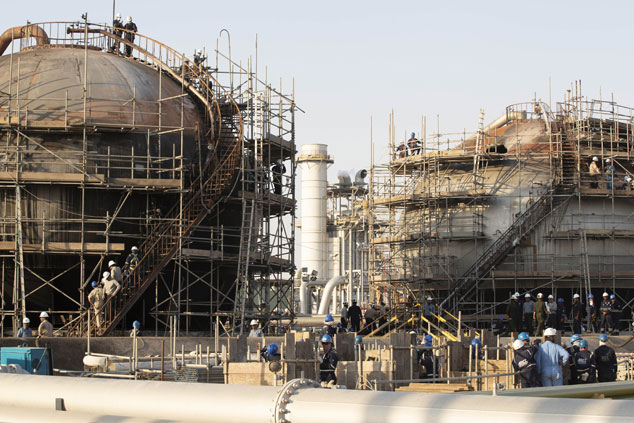
This article is taken from our FREE daily investment email Money Morning.
Every day, MoneyWeek’s executive editor John Stepek and guest contributors explain how current economic and political developments are affecting the markets and your wealth, and give you pointers on how you can profit.
Last weekend, some crucial chunks of Saudi Arabia’s oil processing infrastructure were knocked out by drone attacks.
Before the attacks, the price of a barrel of Brent crude oil was trading at around $60 a barrel.
The price spiked on Monday, shooting up by 20% at one point.
And yet, now Brent really isn’t a lot higher – trading at around $64.50 a barrel this morning.
Is this really all a big fuss about nothing?
An oil shock that fizzled out rapidly
When the news arrived about the drone attacks on Saudi Arabia’s Abqaiq crude processing plant, the outlook seemed pretty bad.
About half of Saudi’s oil output would have to be suspended. That amounts to more than one in 20 barrels of oil being knocked out of global production. That’s a huge amount.
So why did oil end the week little more than 5% higher?
There are some reasons why the market might have taken the disruption more calmly than you might expect.
Firstly, while production has been hit, Saudi Arabia downplayed the length of the disruption. The Saudis rapidly claimed to have restored half of the lost production, and argue that output would be restored fully by the end of September (although full production capacity would not be available until the end of November).
So in theory at least, the hit was not as drastic as first expected.
To be clear, you have to take this with a pinch of salt. As the FT pointed out last week, the Saudis have good reasons to downplay the drama. You might think that they might welcome an excuse to drive the oil price higher. But they also have to present themselves as a reliable supplier of oil.
One problem these days is that, with the US an increasingly important rival energy power, Saudi Arabia and the older oil powers don’t want to risk customers restructuring their supply arrangements.
Also, the Saudis are still keen to get investors to pay a high price for Aramco, the state-owned oil company. It won’t look good for the IPO if one of the risk factors involves the relative ease of stopping production with a handful of drones.
So in this case, it definitely suits the Saudis to present a “glass half-full” picture. Others with knowledge of the damage “cautioned that the energy minister’s statement was optimistic,” notes the FT.
In reality, it’s more likely that the damage isn’t being fixed as quickly, but that Saudi Arabia has enough reserves to maintain the amount of oil hitting the market, and it can presumably top up those reserves once production is fully restored.
The other main reason for oil dropping off is simply the continued gloom around the state of the global economy. Manufacturing across the world is in recession. The consumer side of the global economy is tough enough to be able to shrug that off – so far.
Oil might not surge soon, but it’s hard to see it collapsing
So, on the one hand, you can see why the market has remained relatively calm after the initial spike.
However, there are reasons to believe that this equilibrium might be rather fragile.
There’s the obvious issue – even by the standards of the region, this has to ratchet up the tension in the area. For a start, Saudi Arabia and the US are both blaming Iran for the attack.
Secondly, if it’s this easy to wreak havoc on the Saudi production network, then why couldn’t it happen again?
Capital Economics – while considering the scenario unlikely – reckons that further attacks or even a “full-blown conflict” could drive the price of Brent “well above $100 per barrel.”
Moreover, there’s this question of there being “too much supply” in the market. There seems to be a lot of confidence that this is the case. And I have no specific reason to doubt this.
The main issue, though, is that experience tells me that the narrative on oil (and most other markets for that matter), can turn very rapidly. Get a few pieces of economic data that are more optimistic than expected – or signs of a trade deal between the US and China – and suddenly you might find that the oil market is a lot tighter than anyone had expected.
In short, I’m not saying that the oil price is going to rocket a lot higher from here. But the market does strike me as being psychologically geared to the downside, whereas I suspect it’s a lot more likely that future surprises will be to the upside.
So hang on to your oil investments. As my colleague Merryn Somerset Webb pointed out recently, there could be a fair bit more value in these “stranded assets” still.